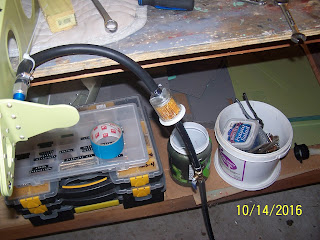Update: The flow tests documented below with color photographs were performed in October 2015, as noted by the timestamps on those pictures. Since that time, I have redesigned the fuselage portion of the wing tank vent system. All of the changes associated with the redesigned vent system necessitated another set of flow tests which were not documented with photography. Additionally, these original tests produced overly optimistic flow rates due to a siphon effect which was unknowingly created by draping the exiting fuel line over the edge of the test bench.
The most recent flow tests (performed in December 2015 and January 2016) performed with the modified vent system eliminated the error created by the siphon and yielded an accurate picture of the fuel system's flow performance. These latter tests were performed by timing the accumulated weight of fuel, in one pound increments, as it drained from the fuselage standpipe (think of it as a header tank) after the wing was fueled.
The screen capture below is a final flow test of the left wing featuring about 32 pounds of gasoline, configured as it will be installed on the fuselage for conventional flight. As you can see, the flow rates ranged from a high of 7.66 gallons per hour down to 6.89 gph...and this is the last 5+ gallons of gas in a 10 gallon wing tank. Of course since the wing is statically tested, there is no favorable pressure gradient from the belly vents to assist the gravity flow. Even so a nominal 7 gph per wing (14 gph for the system) should yield a very respectable flow to an engine that really cannot consume more than about 7 gph at redline. A second screen capture (below this one) shows the same flow test with the conventional vent system and the fuel cap removed for additional venting. An increase in flow rate of about 10% resulted from this other test.
Here is the second test with the modified (fuel cap removed from wing tank) vent system. It shows about a 10% increase in flow rates.
That's about it for the documentation on the final wing tank installation that I will be flying with.
=========================================================================
PLEASE IGNORE THE FOLLOWING PICTURES AND TEXT AS THEY WERE AN INTERMEDIATE RESULT AND DO NOT REFLECT THE FINAL CONFIGURATION OF THE FUEL SYSTEM.
=========================================================================
Now that the fuel and vent plumbing in the wing itself is complete, it is time to fill her up and see what happens.
First thing needed is to jig up the wing into it relative position as when mounted on the fuselage. I created a wing tip support jig at the second from the end rib. This jig supported the wing beneath the main spar and aft, toward the midpoint of the remaining portion of the rib, right at the rear, smaller wing tank.
The wing tip jig was made as a result of some measurements at the root end of the wing. I placed the spar pins in their respective holes and laid a level across to find the dihedral angle. At that point, I was then able to create the wing tip jig as shown in the first picture. Below is the spirit level laying across the spar spins. In the left side of the picture is the vent line reaching upward.
I would say that's pretty close to level so the dihedral angle is set.
Another view of the wing showing the drain line and a gas tank at the root end.
Close up of the fuel line running to terminate in the drain tank on the floor.
In the shot below, you can just see the valve downstream of the fuel filter. I ended up reversing their order in subsequent tests and for some reason, the tank seemed to flow better.
Gas flowing...
...and flowing.
Overall, I'm pretty pleased with the results. There were no leaks that I could find. Flow, although not measured, seemed pretty good. One thing that worries me is that after the fuel drained to a stop, I still had about 1 gallon of gas that remained in the tank....not sure what to think about that.
On another positive note, the tank took all but about 15-20 ounces of 10 gallons! Counting the stand pipe int he fuselage, this will be an honest 20 gallon capacity fuel system.







